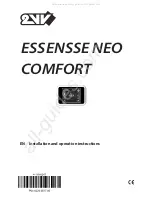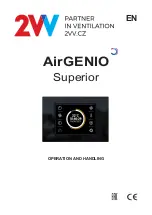
IB140012EN
For more information visit: www.eaton.com
Instructional Booklet
Effective: March 2021
Page
15
Operation and Maintenance Manual,
Automatic Transfer Switch Controller, ATC-900
Section 4: Operation
4.1 General
This section specifically describes the operation and functional
use of the ATC-900. It is divided into three main categories:
•
Automatic Mode;
•
Test Mode; and
•
Programming Mode.
The practical use and operation within each specific category will
be discussed in this section. It is assumed that prior sections were
reviewed and that the operator has a basic understanding of the
hardware. It is important that the operator have a good grasp of
the functional use of the operator panel as covered in Section 3.
This will make movement within each category and between cate-
gories a simple task. This familiarity will quickly put the unsur-
passed capabilities of ATC-900 at the operator’s fingertips.
4.2 Automatic Mode
The Automatic Mode of ATC-900 provides for automatic transfer
and re-transfer from source to source as dictated by the features
supplied and their programmed setpoint values. It provides a sum-
mary of ATC-900’s intelligence and supervisory circuits which
constantly monitor the condition of both Normal and Emergency
power sources thus providing the required intelligence for transfer
operations. These circuits, for example, automatically initiate an
immediate transfer of power when power fails or voltage levels
drop outside a preset value. Exactly what the ATC-900 will initi-
ate in response to a given system condition depends upon the
combination of standard and selected optional features.The user
may program several features and Input/Output functions.
Optional features are: Closed Transition, Current Metering, and
Ethernet. Refer to Section 1.4.2
When the preferred source is connected and the automatic trans-
fer switch is operating normally, the status appears in the display
window. In the event of a power failure, the display automatically
becomes active, showing the status of timers relative to an alter-
nate source transfer. Once the alternate source becomes avail-
able, the transfer is made consistent with pre-programmed
features. In a similar manner, transfer back to the preferred source
is made once the preferred source is again available. System con-
ditions relative to the sources and the load are clearly indicated by
the LED type mimic bus.
4.2.1 I/O Functions & Contact Ratings
As described in Section 2, the rear access area provides for
access to all input connections. The output relay contacts are
rated for 10 A, 1/3 HP @ 250 Vac. The DC rating is 10 A @24
Vdc. Each contact input (same for I/O Module) provides a wetted
24 Vdc at 10 mA. Refer to Figure
2
for a graphical representation
and position of all input connections. There are two types of I/Os,
programmable and fixed. Most I/O are programmable by the user
at any time. There are a few that are fixed from the factory.
These I/O are fixed as the functions they performed are critical or
defined by factory installed hardware, and should not be repro-
grammed by a user. For example, on switches equipped with ser-
vice entrance, one of the programmable inputs would be
permanently set to "Go to Neutral".
The ATC-900 provides for four in and four out programmable
I/Os.
Source 1 Auxiliary Close
This input is located on pins 1 and 2 of connector J6 and factory
wired to the Source 1 breaker (or contactor) auxiliary contact that
is closed when the Source 1 breaker is closed.
S1 Available
This Form C relay is used to indicate the availability of Source 1.
The full Form C contact of this relay is implemented with common
pin 1, normally closed (NC) pin 3, and normally open (NO) pin 2 of
connector J4. This relay essentially duplicates the Source 1 avail-
able status LED meaning that the setpoint criteria has been met.
The relay contacts are rated for 10 A, 1/3 HP @ 250 Vac. The DC
rating is 10 A @24 Vdc.
S2 Available
This Form C relay is used to indicate the availability of Source 2.
The full Form C contact of this relay is implemented with common
pin 4, normally closed pin 6, and normally open pin 5 of connector
J4. This relay essentially duplicates the Source 2 available status
LED meaning that the setpoint criteria has been met. The relay
contacts are rated for 10 A, 1/3 HP @ 250 Vac. The DC rating is
10 A @24 Vdc.
Source 2 Auxiliary Close
This input is located on pins 3 and 4 of connector J6 and wired to
the Source 2 breaker (or contactor) auxiliary contact that is closed
when the Source 2 breaker is closed.
S1 Generator
This latched coil relay provides a Form C contact on pins 1(COM),
2 (NO), 3 (NC) of connector J15. The relay is the generator start
relay for system configurations employing a generator on the
input source designated Source 1. The generator start relay con-
tacts are rated for 10 A, 1/3 HP @ 250 Vac. The DC rating is 10
A @ 24 Vdc with a 150 W maximum load.
S2 Generator
This latched coil relay provides a Form C contact on pins 4
(COM), 5 (NO), 6 (NC) of connector J15. The relay is the genera-
tor start relay for system configurations employing a generator on
the input source designated Source 2. The generator start relay
contacts are rated for 10 A, 1/3 HP @ 250 Vac. The DC rating is
10 A @ 24 Vdc with a 150 W maximum load.
NOTICE
IT IS IMPORTANT TO REMEMBER THAT ATC-900 CONTINUES TO
PROVIDE PROGRAMMED PROTECTION AND AUTOMATIC OPERA-
TION NO MATTER WHICH MODE THE DEVICE IS IN AT THE TIME IT
IS CALLED UPON TO OPERATE.
NOTICE
THE ATC-900 CONTROLLER MUST BE PROPERLY GROUNDED AT J-
4, PIN 19 FOR PROPER OPERATION..
NOTICE
CERTAIN INPUTS MAY NOT BE OPERATIONAL DEPENDING ON USER
PURCHASED OPTIONS.
















































